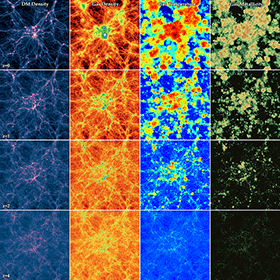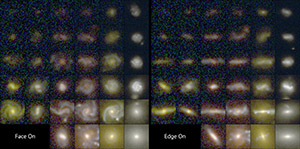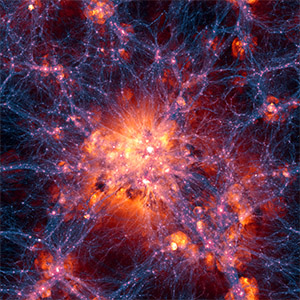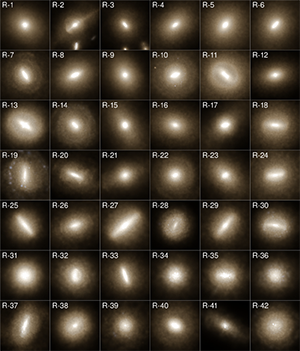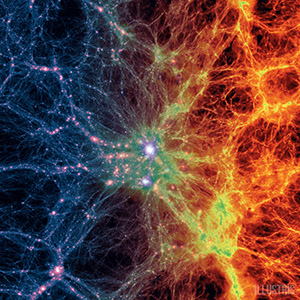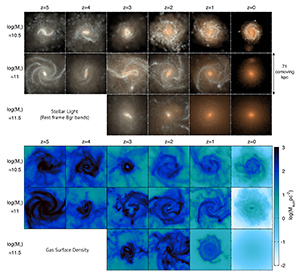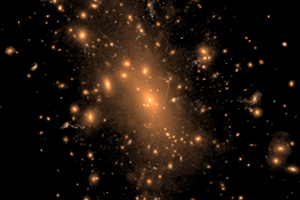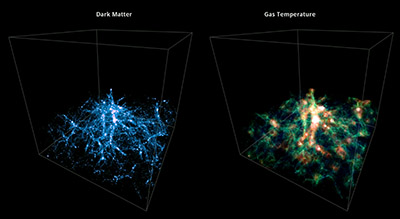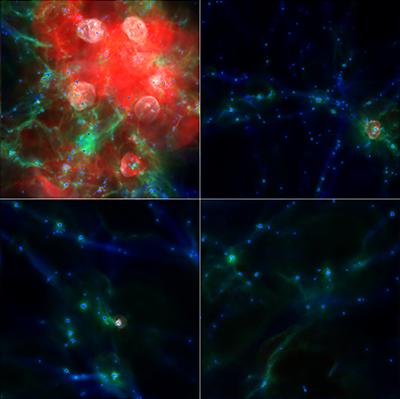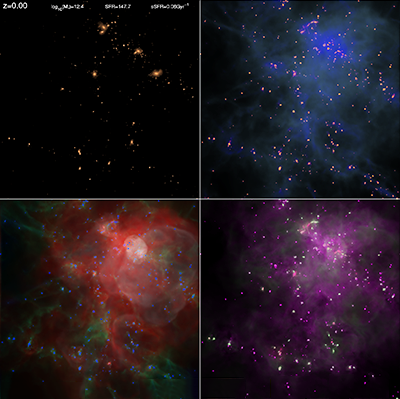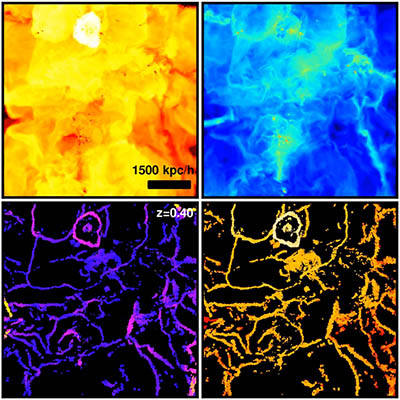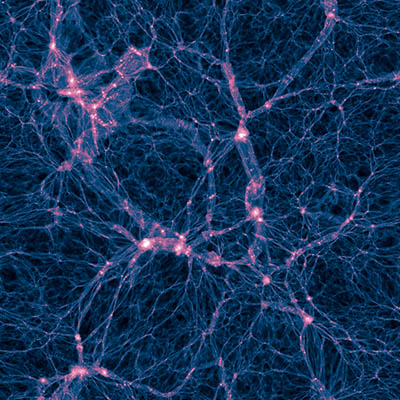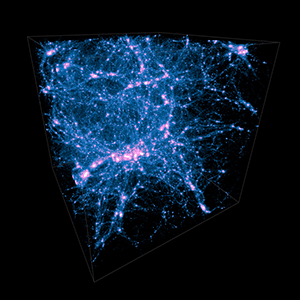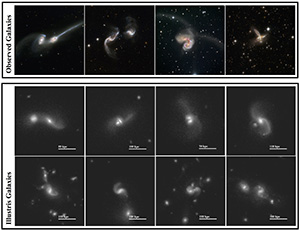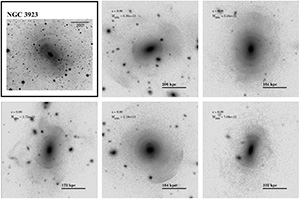Media Images, videos, and other data visualizations.
Note: that everything on this page is intended for public distribution. Anyone is welcome to download, distribute, and share images/videos presented here. For presentation in talks, posters, etc we would anticipate a text credit to "Illustris Collaboration" / "Illustris Simulation". Each image links to a larger version. Some images have additional, particularly large versions available (e.g. for printing).
For any commercial (non-academic) uses please contact us first.
Images:
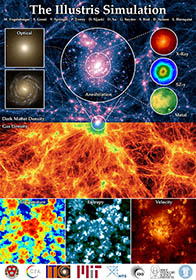
Illustris simulation overview poster. Shows the large scale dark matter and gas density fields in projection (top/bottom). The lower three panels show gas temperature, entropy, and velocity at the same scale. Centered on the most massive cluster, for which the circular insets show four predicted observables. The two galaxy insets highlight a central elliptical and a spiral disk satellite (top/bottom).
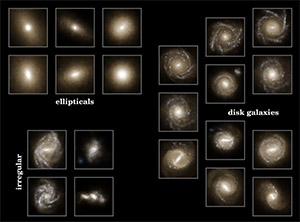
Stellar light distributions (g,r,i bands) for a sample of galaxies at z = 0 arranged along the classical Hubble sequence for morphological classification. Our simulation produces a variety of galaxy types ranging from ellipticals to disk galaxies to irregular systems, the latter mostly resulting from interactions and mergers.
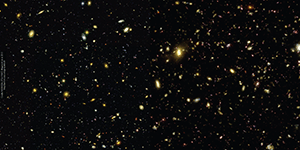
Hubble eXtreme Deep Field observations (2.8 arcmin on a side) in B, Z, H bands convolved with Gaussian point-spread functions of sigma = 0.04, 0.08, and 0.16 arcsec, respectively. Divided down the middle: real observation (left side) and mock observation from Illustris (right side).
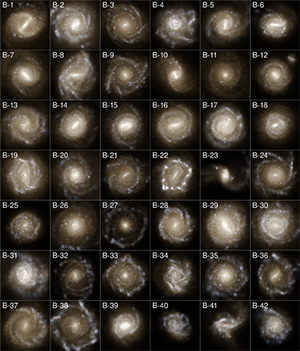
Sample of 42 blue, disk galaxies, showing the stellar light distribution (SDSS g,r,i band composites).
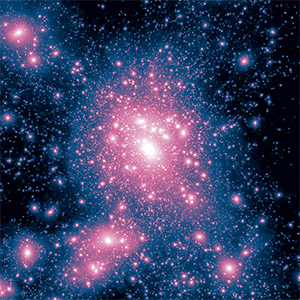
Dark matter annihilation radiation map of the most massive cluster at z=0, from a region enclosing three times the virial radius. The FoF group of this cluster only has over 65 million DM particles and 16,937 resolved substructures.
Videos:
Encoded in H.264 format, available in 1080p widescreen HD (1920x1080), or 1000x1000 for square movies. For higher resolution (4K) please contact us.
Two great compilation videos are also available on Youtube: to compute the laws of nature (6:45 with music), and the Nature video a virtual universe (4:10 with narration).
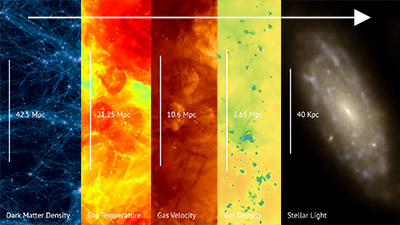
Continuous zoom-in from the scale of the entire simulation volume (~100 Mpc) to the scale of an individual spiral galaxy (~10 kpc), highlighting the diversity of structure across spatial scale, the large dynamic range of the simulation (106 per dimension), and the relationship between dark matter, gas, and stars.
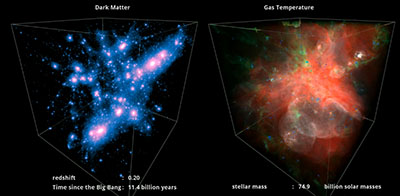
Time evolution of a 10Mpc (comoving) cubic region within Illustris, rendered from outside. The movies shows on the left the dark matter density field, and on the right the gas temperature (blue: cold, green: warm: white: hot). The rapid temperature fluctuations around massive haloes are due to radiative AGN feedback that is most active during quasar phases. The larger 'explosions' are due to radio-mode feedback.
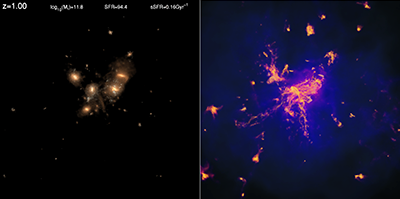
Time evolution from high redshift to z=0, demonstrating the formation of a massive elliptical 'red-and-dead' galaxy as a result of a multiple merger around z~1. Panels show stellar light (left) and gas density (right) in a region of 1 Mpc on a side.
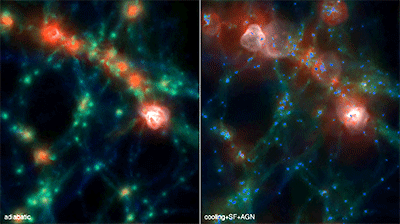
Time evolution of a 10Mpc (comoving) over-dense region within Illustris. While the right side shows a full-physics simulation that includes gas cooling, as well as stellar and black hole formation and feedback, the left side shows a simple simulation of the same region, which includes only gravity and hydrodynamics.
Additional Videos:
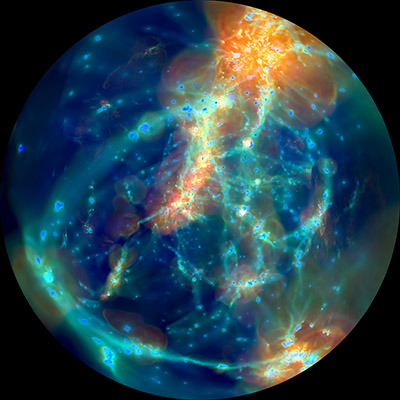
Dome master down-sampled to 2k, 180 degree view, monoscopic. Meant to be viewed in a full-dome digital planetarium. For full 4K or 8K frames please contact us. Shows the evolution of the universe from shortly after the Big Bang to the present day, in gas temperature (blue: cold, green/orange: warm, red/white: hot).
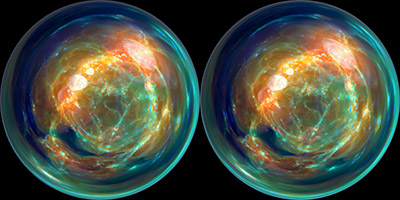
Full 360 degree, stereoscopic (left/right) render. Meant to be viewed in the Oculus Rift, with a tool such as the Whirligig Player, which will let you "look around" as the universe evolves around you. Visualizes the evolution of cosmic gas temperature on scales of ~10 Mpc from shortly after the Big Bang to the present day (blue: cold, green/orange: warm, red/white: hot). 4096x2048 resolution.
Additional Images:
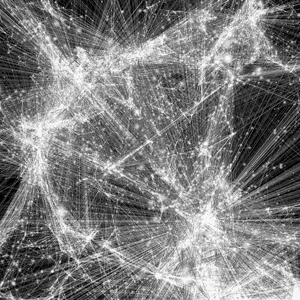
Visualization of the network-like topology of the Illustris-1 galaxy distribution from the point of view of graph theory. (Credit: Kim Albrecht. See the Cosmic Web Project Website for more).
